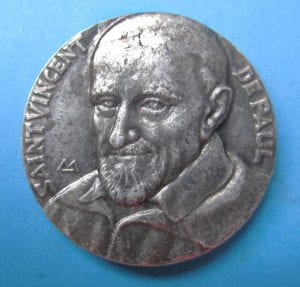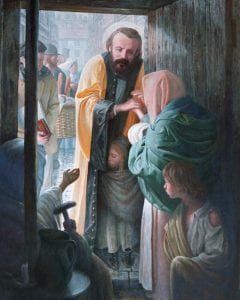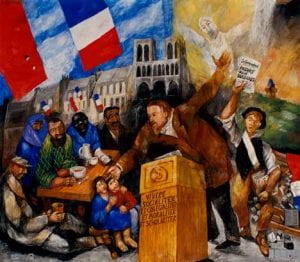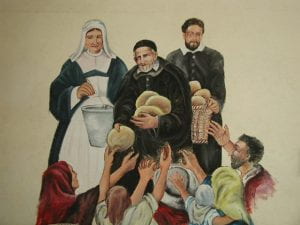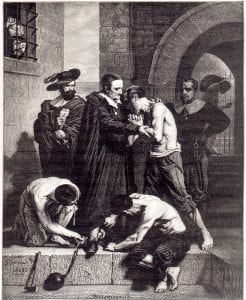The 1947 French film Monsieur Vincent opens with a striking sequence during which Vincent de Paul arrives at the city of Châtillon to serve as a priest. Châtillon is depicted as a place where the sick and the poor are left to die. Meanwhile, the rich party behind closed doors as the plague sweeps through town. Everyone has seemingly lost faith. People laugh when Vincent tells them he has come to serve as priest, horrified that he intends to assist the poor and the sick most of all. While Vincentian historians may point out the many ways this dramatization conflicts with historical record, it does bear a thematic resemblance to some of the testimonies given by residents during the investigation for the canonization of Vincent after his death.
Although we are fortunate to have many volumes of letters and conferences by Saint Vincent, we are sometimes stymied in our search to better understand details of Vincent’s life. He seems to have been reluctant to talk about himself, especially his past. In his spiritual urging of others, Vincent was often self-deprecating and humble. He was fond of referring to his peasant origins and his childhood tending animals, which was understood to be very humble work. Of course, in many spiritual traditions the work of the shepherd is linked to the tasks of prophets and other servants of the divine. Indeed, in the Muslim tradition, the Prophet Muhammad affirms that in his youth he too served as a humble shepherd and that in fact this is true of all the prophets of God.
In addition to the inherent humility of this occupation, many have written of the important lessons one learns from this type of work in order to “pastor” human persons. In another hadith, or prophetic teaching, Prophet Muhammad peace be upon him, is reported to have said, “All of you are shepherds and each of you is responsible for their flock.” A central aspect of the value of personalism embraced at DePaul can be found in this shared human understanding of pastoral responsibility. Margarita Mooney Suarez has described personalism as a “middle way between radical individualism and collective authoritarianism.”[1] In the pastoral wisdom of personalism one may be responsible for a group, whether large or small, but one can only fulfill that responsibility by recognizing the sacred dignity and uniqueness of each of the persons under their care.
The Qur’an calls the attention of the listener to the revival of the earth, which appears dead, with the coming of the rain: “And among His signs is that you see the earth devoid of life, but as soon as We send down rain upon it, it begins to stir ˹to life˺ and swell. Indeed, the One Who revives it can easily revive the dead.”[2] In this and other verses like it, the Qur’an affirms both an everlasting life for the soul after death and the revival of hearts which appear dead. I would argue that in the sacred attention and care that accompanies personalism, one can find not only a revival of individual hearts but of communities that may appear dead or devoid of vibrancy.
This is one lens through which to understand the testimonies of those in Châtillon detailing Monsieur Vincent’s effect over several months in 1617. After someone has a wonderful revival experience it is often difficult to communicate the depth of that to others. When individuals testify to an important life-giving change they often emphasize or even exaggerate the more negative aspects of their prior life. Sometimes this is done to make their story more compelling or dramatic, but just as often it is a desperate attempt to convey just how important and beautiful the change was for them.
Both individually and as an institution, as we continue the process of revival in emerging from the depths of the pandemic and the many other difficulties we have faced, let us embrace sacred attention to all those under our care. Furthermore, let us remember and celebrate the countless sacred acts that carried us through our lowest moments and prepared us for the coming of a new spring.
Reflection by: Abdul-Malik Ryan, Asst. Director Religious Diversity & Pastoral Care, Muslim Chaplain
[1] Margarita Mooney Suarez, “Being Human in the Modern World: Why Personalism Matters for Education and Culture,” 25 June 2018, Public Discourse, at: https://www.thepublicdiscourse.com/2018/06/21942/.
[2] Quran 41:39.




